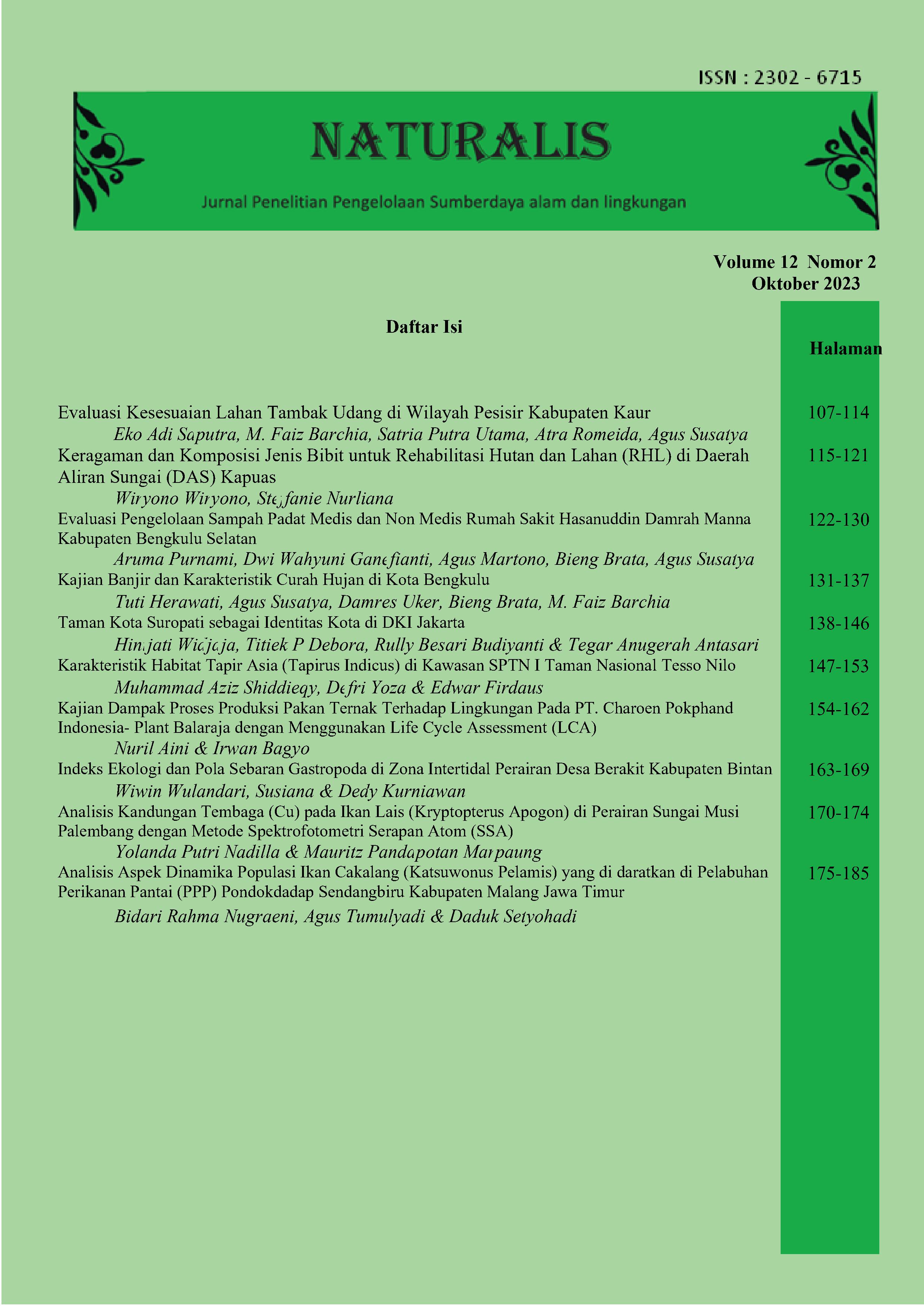Kajian Dampak Proses Produksi Pakan Ternak Terhadap Lingkungan Pada PT. Charoen Pokphand Indonesia- Plant Balaraja dengan Menggunakan Life Cycle Assessment (LCA)
Abstract
Produksi pakan ternak mulai dari pengumpulan bahan baku dan proses pengemasan berpotensi menimbulkan dampak terhadap lingkungan. Penelitian ini bertujuan untuk menganalisis dampak utama terhadap lingkungan, mengidentifikasi unit proses mana yang memiliki dampak paling signifikan terhadap lingkungan dan menentukan program atau inovasi alternatif yang dapat mengurangi isu lingkungan. Analisis materi dilakukan dengan Life Cycle Assessment (LCA), menggunakan Microsoft excel. Hasil analisis LCA digunakan sebagai dasar untuk menentukan program alternatif yang terkait dengan efisiensi energi dan pengurangan emisi. Keluaran dari penelitian ini adalah tercapainya program alternatif yang dapat mengurangi dampak produksi terhadap lingkungan sebagai sarana perbaikan berkelanjutan pada pengelolaan lingkungan dan untuk mewujudkan visi perusahaan menjadi perusahaan penyedia makanan dunia dengan kualitas dan inovasi. Kategori dampak yang timbul akibat pembakaran boiler batubara adalah Acidification sebesar 0,016219465 kg SO2 eq, Eutrophication sebesar 0,035894938 kg PO4 eq, human toksisitas 0,033326886 kg 1,4-DB eq , dan photochemical Oxidation sebesar 0,00087127 kg C2H4 persamaan Unit proses yang juga menimbulkan dampak lingkungan pembakaran boiler menggunakan bahan bakar gas alam dengan kategori dampak yang timbul adalah pemanasan global sebesar 0,648912941 kg CO2 eq.
Kata Kunci: Feedmill, Life Cycle Assessment (LCA)
Full text article
References
[2] EPA. 2006. Life Cycle Assesment: Principles and Practice.
[3] GPMT, (2021). Tentang GPMT [Online] Gabungan Pengusaha Makan Ternak. Available at https://gpmt.or.id/id [Diakses 20 Desember 2020]
[4] Hermawan, (2013). Peran Life Cycle Analysis (LCA) pada Material Konstruksi dalam Upaya Menurunkan Dampak Emisi Karbon Dioksida pada Efek Gas Rumah Kaca. Surakarta, Konferensi Nasional Teknik Sipil 7 UNS.
[5] Liu Y dan Chen J. 2018. Phosphorus cycle. Reference Module in Earth Systems and Environmental Sciences .doi.org/10.1016/B978-0-12- 409548-9.09043
[6] Noel de Nevers. 2000. Air Pollution Control Engineering. 2nd Ed. Mc Graw- Hill. Boston
[7] Norton SA, Kopa?c?ek J, dan Fernandez IJ. 2013. Acid rain - acidification and recovery. Treatise on Geochemistry 2nd Edition. doi.org/10.1016/B978-0-08-095975-7.00910- 4
[8] PermenLH No. 7 Tahun 2007 (2013). Tentang Baku Mutu Tidak Bergerak bagi Ketel Uap
[9] PermenLH No. 3 Tahun 2013. (2013). Audit Lingkungan Hidup.
[10] PermenLHK No. 1 Tahun 2021. (2021). Program Penilaian Peringkat Kinerja Perusahaan Dalam Pengelolaan Lingkungan Hidup.
[11] PermenLHK No. 3 Tahun 2021. (2021). Standar kegiatan usaha pada penyelenggaraan perizinan berusaha berbasis risiko sektor lingkungan hidup dan kehutanan.
[12] PermenLHK No. 4 Tahun 2021. (2021). Daftar Usaha dan/atau Kegiatan yang Wajib Memiliki Analisis Mengenai Dampak Lingkungan Hidup, Upaya Pengelolaan Lingkungan Hidup dan Upaya Pemantauan Lingkungan Hidup.
[13] PermenLHK No. 5 Tahun 2021. (2021). Penyelenggaraan Perizinan Berusahan Berbasis Risiko.
[14] PermenLHK No. 6 Tahun 2021. (2021). Tata Cara Persyaratan Pengelolaan Limbah Bahan Berbahaya dan Beracun.
[15] PermenLHK No. 11 Tahun 2021. (2021). Baku Mutu Emisi Mesin dengan Pembakaran Dalam.
[16] Peraturan Pemerintah RI No.22 Tahun 2021. (2021). Peraturan Pemerintah Republik Indonesia Nomor 22 Tahun 2021 Tentang Penyelenggaraan Perlindungan dan Pengelolaan Lingkungan Hidup.
[17] Soimakallio, S., Kiviluoma, J., Saikku, L. (2011). The Complexity and Challenges of Determining GHG (GreenHouse Gas) Emissions from Grid Electricity Consumption and Conservation in LCA (Life Cycle Assessment): A Methodological Review. Energy, 36, 6705–6713
[18] Utina, R. (2015). Pemanasan Global: Dampak dan Upaya Meminimalisasinya". Jurnal Saintek Universitas Negeri Gorontalo, Vol. 3 (3): 1-11.
Authors
Copyright (c) 2023 Nuril Aini

This work is licensed under a Creative Commons Attribution-ShareAlike 4.0 International License.
An author who publishes in Naturalis agrees to the following terms:
Author retains the copyright and grants the journal the right of first publication of the work simultaneously licensed under the Creative Commons Attribution-ShareAlike 4.0 License that allows others to share the work with an acknowledgement of the work's authorship and initial publication in this journal
The author is able to enter into separate, additional contractual arrangements for the non-exclusive distribution of the journal's published version of the work (e.g., post it to an institutional repository or publish it in a book) with the acknowledgement of its initial publication in this journal. The author is permitted and encouraged to post his/her work online (e.g., in institutional repositories or on their website) prior to and during the submission process, as it can lead to productive exchanges, as well as earlier and greater citation of the published work (See The Effect of Open Access).
Submission of a manuscript implies that the submitted work has not been published before (except as part of a thesis or report, or abstract); that it is not under consideration for publication elsewhere; that its publication has been approved by all co-authors. If and when the manuscript is accepted for publication, the author(s) still hold the copyright and retain publishing rights without restrictions. Authors or others are allowed to multiply an article as long as not for commercial purposes. For the new invention, authors are suggested to manage its patent before published. The license type is CC-BY-SA 4.0.
Naturalis is licensed under a Creative Commons Attribution-ShareAlike 4.0 International License.

